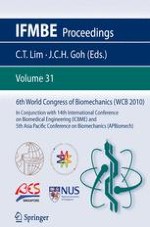2010 | OriginalPaper | Chapter
Development of an Energy Storage and Return Knee Brace
Authors : C. H. Cheong, K. Z. Chen, T. Lee, J. Z. Li, H. N. Tan, K. Y. Seng
Published in: 6th World Congress of Biomechanics (WCB 2010). August 1-6, 2010 Singapore
Publisher: Springer Berlin Heidelberg
Activate our intelligent search to find suitable subject content or patents.
Select sections of text to find matching patents with Artificial Intelligence. powered by
Select sections of text to find additional relevant content using AI-assisted search. powered by
A lightweight prototypic energy storage and return (ESR) knee brace was developed to offer protection against anterior cruciate ligament (ACL) injury and to assist locomotion about the knee joint for the healthy individual.
Protection is achieved via the mitigation of excessive anterior tibial translation (ATT) and axial rotation of the tibia relative to the femur that leads to ACL rupture. Cadaveric knee specimens were tested under incremental drop-land compressive impact loads to obtain the ACL failure impact load and ATT limits. A finite element knee model, verified by the experimental data, was utilized to obtain the transverse planar axial torsion and angular rotation limits of the knee joint that leads to ACL failure. In the attempt to mitigate excessive ATT, care was exercised to minimize overconstraining the knee joint by allowing the physiological range of ATT. The completed ESR knee brace prototype was assessed for its protection efficacy on a knee surrogate fixture using a test system. The results indicated a protection level that is well within the impact and twisting limits for ACL rupture.
Assistance to locomotion was achieved by storing energy in the brace joint during knee flexion and returning the stored energy during knee extension. This functional aspect was tested on 10 healthy male volunteers of weight, height and age averaged at 61.5 ± 7.1kg, 1.70 ± 0.05m and 24.9 ± 1.5 years old. The volunteers performed a 60 cm high drop-landing without and with the ESR knee brace worn. Surface EMG data on the leg muscles was measured together with lower limb motion and ground reaction force data. The EMG work done and mean EMG in the quadriceps showed significant (P<0.05) reduction during the landing and rising phases of the maneuver by up to 23% and 27% respectively. Biomechanical results also showed significant reduction of 10.8% in peak energy generation during the rising phase.
